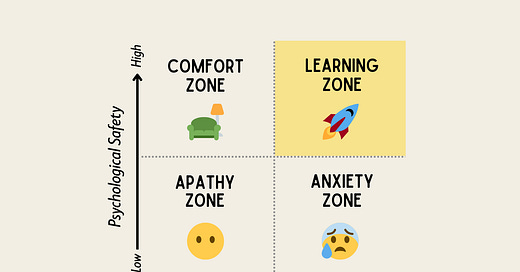The Four Zones of Psychological Safety: Where Does Your Team Sit?
If Your Team Isn’t in the Learning Zone, You’ve Got a Problem
In this issue:
What is the Psychological Safety Framework?
Applying the Psychological Safety Framework
Moving to the Learning Zone
Real-Life Leadership Scenarios
Common Mistakes to Avoid
The Psychological Safety Worksheet
Complementary Frameworks
Recommended Resources
Final Takeaway
✨
A few years ago, I took over a new team. Smart folks. Great resumes.
But something felt off.
They rarely spoke in meetings. When I asked questions, I got polite nods—but not real answers. And deadlines kept slipping.
At first, I thought it was a talent issue.
I then noticed that the water-cooler conversations weren’t happening near the water-cooler. They were happening behind closed doors.
But after a few one-on-ones, I realized the problem was deeper.
People were afraid.
They were afraid of saying the wrong thing. Of being blamed. Of looking bad.
One of the team members mustered up the courage and told me, “We’re told to speak up—but when someone did, they were shut down in front of everyone.”
That’s when it hit me.
The team didn’t lack skill. They lacked psychological safety. And without that, no amount of pressure or motivation was going to help.
You can have the smartest team in the room. Give them all the tools. The clearest goals. The biggest vision. But if they don’t feel safe to speak up, ask questions, or admit mistakes—none of it matters. They’ll hold back. They’ll play it safe. And slowly, things will fall apart.
On the flip side, if you make them feel safe but never push for results, you’ll get camaraderie—but not much progress.
As a leader, your job is to strike a balance.
What is the Psychological Safety Framework?
The Psychological Safety Framework is a tool to help leaders create a high-performance team culture—one where people feel safe speaking up and accountable for delivering.
It rests on two pillars:
Psychological Safety: The freedom to express yourself without fear of judgment or punishment.
Accountability: The responsibility to meet goals and deliver results.
The power of this framework lies in how these two forces interact. Put them on a matrix, and you get four distinct team cultures:
🛋️ Comfort Zone: High safety, low accountability
😶 Apathy Zone: Low safety, low accountability
😰 Anxiety Zone: Low safety, high accountability
🚀 Learning Zone: High safety, high accountability
Only one of them leads to growth.
Let’s break down each zone:
🛋️ Comfort Zone
People feel safe, but no one is pushing for results.
It’s cozy, but not challenging.
You’ll see this in teams where underperformance is tolerated, and feedback is rare.
😶 Apathy Zone
No one feels heard. No one is held responsible.
It’s quiet—but not in a good way.
People give up, disconnect, or do the bare minimum.
😰 Anxiety Zone
Expectations are high, but it’s not safe to ask questions or challenge ideas.
Every mistake feels risky.
People cover up issues instead of solving them.
🚀 Learning Zone
People are trusted and challenged.
They speak up, ask for help, try new things—and take ownership of results.
This is where creativity, trust, and excellence thrive.
Applying the Psychological Safety Framework
Okay, now that we understand the four zones of Psychological Safety, we know we should strive to move our team to the Learning Zone.
But how exactly do you do that?
Now, let’s turn our attention to making this framework work for you in your role as a leader.
Next, we will:
Explore specific steps you can take to move your team into the Learning Zone
Explore three real-life leadership scenarios, and understand what “being in the different zones” looks like and feels like.
Review common mistakes you should avoid while using this framework
Make it real: Put the power of this framework into practice with the Psychological Safety Framework worksheet, which includes step-by-step prompts to guide you through the application process. (Note: Paid members enjoy FREE access to the entire collection of worksheets!)
Review some complementary frameworks that work well with the Psychological Safety framework
Review additional resources to further your understanding
Close out with some key takeaways




